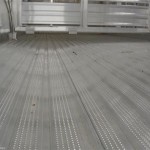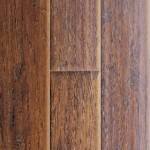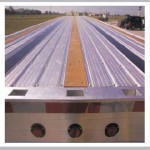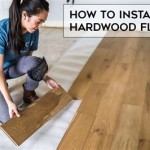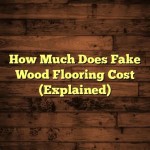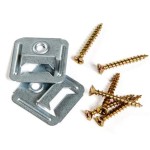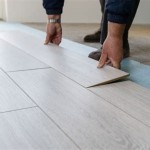Does Vinyl Plank Flooring Look Like Wood? A Detailed Examination
Vinyl plank flooring has become an increasingly popular choice for homeowners and businesses alike, largely due to its durability, water resistance, and relatively affordable price point. A significant factor driving this popularity is its ability to mimic the aesthetic of natural wood flooring. However, the question remains: does vinyl plank flooring truly look like wood, and if so, how effectively?
The answer is nuanced. Vinyl plank flooring can, indeed, resemble wood quite convincingly. Advancements in manufacturing technology have enabled the creation of vinyl planks with intricate textures, realistic grain patterns, and subtle color variations that closely emulate the appearance of various wood species. However, the degree to which vinyl plank successfully replicates the look of wood depends on several factors, including the quality of the materials used, the manufacturing process, and the specific design choices employed.
Understanding the intricacies of vinyl plank flooring and its ability to mimic wood involves examining the various aspects that contribute to its visual appeal. This encompasses the design layer, the texture, the installation method, and the overall context in which the flooring is placed.
The Design Layer: The Foundation of the Wood Look
The design layer, also known as the decorative layer, is the crucial component of vinyl plank flooring responsible for replicating the appearance of wood. This layer is a high-resolution printed image of wood grain, knots, and other natural imperfections found in real wood. The quality of this image directly impacts the realism of the vinyl plank.
High-quality vinyl plank flooring utilizes advanced printing technology to create incredibly detailed and lifelike images. These images are often derived from photographs of actual wood planks, capturing the unique characteristics of different wood species, such as oak, maple, hickory, and walnut. The printing process incorporates subtle variations in color and tone to mimic the natural aging and weathering of wood.
Lower-quality vinyl plank flooring may employ simpler printing techniques and less detailed images, resulting in a more artificial and repetitive appearance. The patterns might be less intricate, and the color variations may be less subtle, making the flooring appear less realistic.
Furthermore, the thickness of the wear layer, which sits atop the design layer, can also affect the perceived depth and clarity of the wood grain. A thicker wear layer provides greater protection against scratches and scuffs, ensuring that the design layer remains visible and vibrant for a longer period.
Texture and Embossing: Adding Depth and Realism
While the design layer provides the visual foundation for the wood look, the texture and embossing add a tactile dimension that enhances the realism. Embossing involves creating a three-dimensional surface on the vinyl plank that corresponds to the printed wood grain. This creates a texture that mimics the feel of real wood, adding to the overall authenticity.
There are different types of embossing techniques used in vinyl plank flooring. One common method is "embossed in register" (EIR), where the embossing precisely aligns with the printed wood grain. This technique creates a highly realistic texture that closely matches the look and feel of real wood. Each knot, groove, and grain line is replicated with precision, adding depth and dimension to the flooring.
Other embossing techniques may involve a more general texture that is not directly aligned with the printed wood grain. While this can still add a tactile element to the flooring, it may not be as convincing as EIR. The texture may feel somewhat artificial or repetitive, detracting from the overall realism.
The depth and intensity of the embossing also play a role in the perceived realism. A deeper and more pronounced texture will generally feel more like real wood than a shallow and subtle texture. However, excessively deep embossing can also appear unnatural or be difficult to clean.
Installation and Context: Completing the Illusion
Even the highest-quality vinyl plank flooring can fall short of its potential if it is not installed properly. A professional and meticulous installation is crucial for achieving a seamless and realistic appearance. Careful attention to detail, such as staggering the planks correctly, using the appropriate underlayment, and ensuring proper subfloor preparation, can make a significant difference.
Staggering the planks randomly is essential for avoiding a repetitive pattern that can detract from the realism. By varying the placement of the planks, the flooring will more closely resemble the natural variations found in real wood. The use of an appropriate underlayment can also improve the comfort and sound insulation of the flooring, making it feel more like solid wood underfoot.
The context in which the flooring is placed also influences its perceived realism. Factors such as lighting, room size, and surrounding décor can affect how the vinyl plank flooring is perceived. Natural light tends to enhance the realism of the flooring by highlighting the textures and color variations. Conversely, harsh artificial lighting can sometimes accentuate the artificial aspects of the flooring.
Furthermore, the overall style and décor of the room can either complement or detract from the wood look. Pairing the vinyl plank flooring with natural materials, such as wood furniture and stone accents, can help to create a cohesive and authentic aesthetic. Conversely, using too many synthetic materials or overly modern décor can make the flooring appear less realistic.
Ultimately, the question of whether vinyl plank flooring looks like wood is subjective and depends on individual perception. However, by understanding the factors that contribute to the visual appeal of vinyl plank flooring, homeowners can make informed choices and select products that effectively replicate the look and feel of natural wood.
The price point of vinyl plank flooring is a significant factor when considering its realism compared to hardwood. High-end vinyl planks with advanced printing and embossing techniques will naturally resemble wood more closely than budget-friendly options. Investing in quality materials and professional installation can significantly improve the overall aesthetic and create a more convincing wood-like appearance.
Another consideration is the specific type of wood that the vinyl plank is attempting to mimic. Some wood species, such as oak, are easier to replicate convincingly due to their relatively simple grain patterns. More complex wood species, such as reclaimed wood with significant character marks and variations, may be more challenging to replicate accurately in vinyl.
It is also important to acknowledge that even the best vinyl plank flooring will not perfectly replicate the look and feel of real wood. There are subtle differences in texture, sound, and overall feel that may be noticeable to discerning individuals. However, for many homeowners, the benefits of vinyl plank flooring, such as its durability, water resistance, and affordability, outweigh the slight compromise in realism.
In conclusion, while vinyl plank flooring may not be a perfect substitute for real wood, advancements in manufacturing technology have made it a viable and attractive option for those seeking the aesthetic of wood without the associated cost and maintenance. By carefully considering the design layer, texture, installation, and overall context, homeowners can confidently select vinyl plank flooring that effectively replicates the natural beauty of wood.
Vinyl Flooring That Looks Like Wood
Vinyl Flooring That Looks Like Wood
Vinyl Flooring That Looks Like Wood
Vinyl Flooring That Looks Like Wood

Vinyl Plank Wood Look Floor Versus Engineered Hardwood Hometalk
Vinyl Flooring That Looks Like Wood

Vinyl Flooring That Looks Like Wood Top Picks 2024 Panel Town Floors
:max_bytes(150000):strip_icc()/J_wcyCT1-7e379c089c8545a0babf4d5235a0a856.jpeg?strip=all)
Vinyl Flooring That Looks Like Wood

Hardwood Vs Luxury Vinyl Plank Flooring The Creative Kitchen Co

Luxury Wood Vinyl Plank Highland Homes Flooring Options
Related Posts

